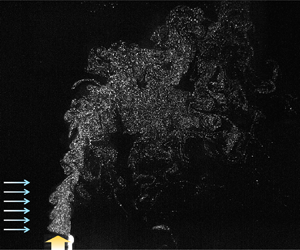Article contents
Particle dispersion induced by vortical interactions in a particle-laden upward jet with a partial crossflow
Published online by Cambridge University Press: 09 March 2021
Abstract

In the present study particle dispersions (concentrations) through vortical interactions are experimentally investigated for a particle-laden upward jet, with a horizontal crossflow covering a vertical range partially near the jet exit (Reynolds numbers of 1170–5200). We focus on the influences of the dynamics of counter-rotating vortex pairs existing in the flow on changes in the particle dispersion patterns, depending on the velocity (jet/crossflow) ratio and particle Stokes number ( $St = 0.01\text {--}27.42$). Without crossflow, there is no dominant vortical structure along the horizontal direction; thus, the particles are not dispersed significantly out of the jet core in most cases, except for the case with the highest particle inertia (i.e.
$St = 0.01\text {--}27.42$). Without crossflow, there is no dominant vortical structure along the horizontal direction; thus, the particles are not dispersed significantly out of the jet core in most cases, except for the case with the highest particle inertia (i.e.  $St$). With crossflow, on the other hand, counter-rotating vortex pairs appear above the jet exit and become stronger as the velocity ratio decreases. With a lower velocity ratio, the vortices are tilted more toward the leeward side and dissipate faster. Driven by the vortex pairs, the drag force acting on the particles becomes stronger and, thus, particles with
$St$). With crossflow, on the other hand, counter-rotating vortex pairs appear above the jet exit and become stronger as the velocity ratio decreases. With a lower velocity ratio, the vortices are tilted more toward the leeward side and dissipate faster. Driven by the vortex pairs, the drag force acting on the particles becomes stronger and, thus, particles with  $St < 1.0$ are dragged out of the jet core following the rotation of the vortices. Those with
$St < 1.0$ are dragged out of the jet core following the rotation of the vortices. Those with  $St \simeq 1.0$ are concentrated between the vortex pairs before the vortices collapse. When
$St \simeq 1.0$ are concentrated between the vortex pairs before the vortices collapse. When  $St \gg 1.0$, particles are simply transported by the inertial effect. Finally, we suggest different regimes for particle dispersion (concentration) as classified by the Stokes number and velocity ratio, and elucidate their mechanisms, which are further extended to empirical particle dispersion models.
$St \gg 1.0$, particles are simply transported by the inertial effect. Finally, we suggest different regimes for particle dispersion (concentration) as classified by the Stokes number and velocity ratio, and elucidate their mechanisms, which are further extended to empirical particle dispersion models.
- Type
- JFM Papers
- Information
- Copyright
- © The Author(s), 2021. Published by Cambridge University Press
References
REFERENCES
- 11
- Cited by



